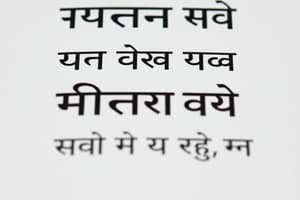Podcast
Questions and Answers
Which script is typically used to write Hindi?
Which script is typically used to write Hindi?
- Devanagari (correct)
- Persian
- Arabic
- Sanskrit
What type of word order does Hindi generally follow?
What type of word order does Hindi generally follow?
- Subject-Object-Verb (SOV) (correct)
- Subject-Verb-Object (SVO)
- Verb-Object-Subject (VOS)
- Verb-Subject-Object (VSO)
Which of the following features characterizes Modern Standard Hindi?
Which of the following features characterizes Modern Standard Hindi?
- Greater use of Sanskrit-derived words (correct)
- Greater use of Persian loanwords
- Greater use of Arabic loanwords
- Rejection of loanwords
What is the term for the shared lingua franca of northern India that includes both Hindi and Urdu?
What is the term for the shared lingua franca of northern India that includes both Hindi and Urdu?
Which of the following influences the vocabulary of Hindi?
Which of the following influences the vocabulary of Hindi?
In which region did Khariboli, the predecessor to Hindi, arise?
In which region did Khariboli, the predecessor to Hindi, arise?
Which script is used for Hindi?
Which script is used for Hindi?
Which of the following is designated as an official language of the Union Government of India?
Which of the following is designated as an official language of the Union Government of India?
From which language does Hindi primarily derive its roots?
From which language does Hindi primarily derive its roots?
Which historical period saw the emergence of Khariboli in the Delhi region?
Which historical period saw the emergence of Khariboli in the Delhi region?
Which term identifies Hindi as the base register of a broader language?
Which term identifies Hindi as the base register of a broader language?
Which of the following is considered a Western Hindi dialect?
Which of the following is considered a Western Hindi dialect?
Who advocated for Hindustani as a unifying national language during the British Raj?
Who advocated for Hindustani as a unifying national language during the British Raj?
Flashcards
Distinctive Vowel Length
Distinctive Vowel Length
Hindi distinguishes meaning through differences in vowel duration.
Nasalized Vowels
Nasalized Vowels
Some Hindi vowels are pronounced with air flowing through the nose.
SOV Word Order
SOV Word Order
Hindi typically orders sentence elements as Subject-Object-Verb.
Synthetic Language
Synthetic Language
Signup and view all the flashcards
Noun Inflection
Noun Inflection
Signup and view all the flashcards
What is Hindi?
What is Hindi?
Signup and view all the flashcards
What is the Hindi Belt?
What is the Hindi Belt?
Signup and view all the flashcards
What is Khariboli?
What is Khariboli?
Signup and view all the flashcards
What language is the root of Hindi?
What language is the root of Hindi?
Signup and view all the flashcards
What languages influenced Hindi's vocabulary?
What languages influenced Hindi's vocabulary?
Signup and view all the flashcards
What is Standard Hindi?
What is Standard Hindi?
Signup and view all the flashcards
What happened during the British Raj?
What happened during the British Raj?
Signup and view all the flashcards
What is the official status of Hindi?
What is the official status of Hindi?
Signup and view all the flashcards
Study Notes
- Hindi is an Indo-Aryan language spoken chiefly in India.
- Modern Standard Hindi is one of the two official languages of the Government of India.
- It is an official language in 9 states and 3 union territories.
- Hindi is the lingua franca of the Hindi belt.
- It is derived from Khariboli dialect of Delhi.
- Hindi has its roots in Sanskrit.
- Hindi incorporates vocabulary from Persian, Arabic, Turkic, and English.
- As a linguistic variety, Hindi is identified as the base register of the Hindustani language.
History
- The predecessor to Hindi is the early form of Hindustani known as Khariboli.
- Khariboli arose in the Delhi region during the Delhi Sultanate period (1206-1526 AD).
- It was influenced by interaction between Indo-Aryan languages and Persian, Arabic, and Turkic languages.
- During the British Raj, efforts were made to standardize Hindustani, leading to two primary registers: Hindi and Urdu.
- Hindi adopted the Devanagari script and leaned towards Sanskrit for vocabulary.
- Urdu adopted a modified Persian script and drew vocabulary from Persian and Arabic.
- Mahatma Gandhi advocated for Hindustani as a unifying national language.
- After independence in 1947, Hindi was adopted as one of the official languages of India.
Geographical Distribution
- Hindi is spoken across the Hindi Belt in northern and central India.
- Hindi is used in states such as Bihar, Chhattisgarh, Haryana, Himachal Pradesh, Jharkhand, Madhya Pradesh, Rajasthan, Uttar Pradesh, Uttarakhand, and West Bengal.
- Hindi Belt includes Delhi and Chandigarh.
- Due to migration, Hindi speakers are present in major cities throughout India.
- Hindi is also spoken by a significant diaspora population worldwide.
Official Status
- Hindi is one of the two official languages of the Union Government of India, along with English.
- Article 343 of the Indian Constitution declares Hindi as the official language of the Union.
- Hindi is the official language of several states and union territories in India.
- The Central Hindi Directorate promotes Hindi.
Dialects
- Hindi exhibits considerable dialectal variation.
- Dialects are often grouped into Western Hindi and Eastern Hindi.
- Western Hindi dialects include Khariboli, Braj Bhasha, Haryanvi, Bundeli, and Kannauji.
- Eastern Hindi dialects include Awadhi, Bagheli, and Chhattisgarhi.
- Khariboli is considered the standard dialect of Hindi.
- The intelligibility between different dialects can vary.
Phonology
- Hindi has a relatively large phoneme inventory.
- It includes aspirated and unaspirated consonants.
- Hindi features retroflex consonants.
- Vowel length is distinctive.
- Hindi has nasalized vowels.
- The phonology of Hindi is influenced by Sanskrit and Persian.
Grammar
- Hindi is an Indo-Aryan language.
- It generally follows Subject-Object-Verb (SOV) word order.
- Hindi is a relatively synthetic language.
- It employs postpositions instead of prepositions.
- Nouns are inflected for gender, number, and case.
- Verbs are inflected for tense, aspect, mood, gender, and number.
- Hindi has a system of grammatical gender.
- Agreement is important in Hindi grammar.
Vocabulary
- The vocabulary of Hindi is influenced by Sanskrit, Persian, Arabic, Turkic, and English.
- Modern Standard Hindi is characterized by greater use of Sanskrit-derived words.
- Urdu, a register of Hindustani, utilizes more Persian and Arabic loanwords.
Writing System
- Hindi is typically written in the Devanagari script.
- Devanagari is an abugida.
- Each consonant has an inherent vowel.
- Vowels can be written as independent letters or as diacritics.
- Devanagari is written from left to right.
Influence
- Hindi is a major language of communication, education, and entertainment in India.
- Bollywood, the Hindi-language film industry, has a significant cultural impact.
- Hindi literature has a rich tradition.
- Hindi is used in television, radio, and print media.
- The influence of Hindi is growing globally due to the Indian diaspora.
Hindustani
- Hindustani is a lingua franca of northern India.
- It encompasses both Hindi and Urdu.
- Hindustani is characterized by a shared core vocabulary and grammar.
- The differences between Hindi and Urdu are mainly in script and higher-level vocabulary.
- In colloquial settings, Hindi and Urdu are mutually intelligible.
Studying That Suits You
Use AI to generate personalized quizzes and flashcards to suit your learning preferences.




